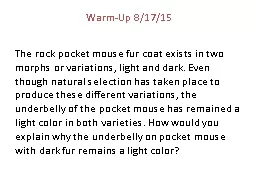PPT-WARM UP
Author : sherrill-nordquist | Published Date : 2015-11-14
Write down objective and homework in agenda Lay out homework WB 86 126 Homework Charity Donations worksheet Warm Up Determine if the sequence is geometric If it
Presentation Embed Code
Download Presentation
Download Presentation The PPT/PDF document "WARM UP" is the property of its rightful owner. Permission is granted to download and print the materials on this website for personal, non-commercial use only, and to display it on your personal computer provided you do not modify the materials and that you retain all copyright notices contained in the materials. By downloading content from our website, you accept the terms of this agreement.
WARM UP: Transcript
Download Rules Of Document
"WARM UP"The content belongs to its owner. You may download and print it for personal use, without modification, and keep all copyright notices. By downloading, you agree to these terms.
Related Documents














